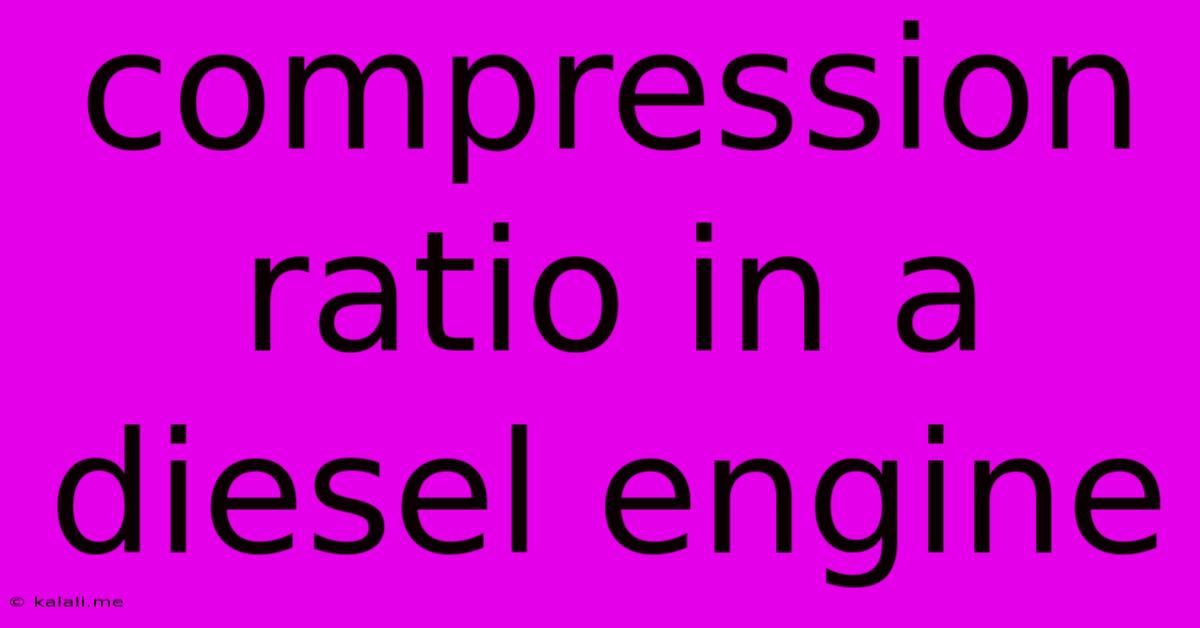Compression Ratio In A Diesel Engine
Kalali
May 22, 2025 · 3 min read

Table of Contents
Understanding Compression Ratio in a Diesel Engine: A Deep Dive
Meta Description: This article explores the crucial role of compression ratio in diesel engines, explaining its impact on efficiency, power output, and emissions. Learn how this key parameter affects engine performance and design considerations.
The compression ratio is a fundamental aspect of internal combustion engine design, significantly influencing its performance and efficiency. In diesel engines, this parameter plays an even more critical role compared to gasoline engines due to the reliance on compression ignition. Understanding compression ratio is key to appreciating the inner workings and optimization of diesel power plants. This article will delve into the intricacies of compression ratio in diesel engines, covering its impact on various engine characteristics and design considerations.
What is Compression Ratio?
The compression ratio is simply the ratio of the volume of the cylinder when the piston is at the bottom of its stroke (Bottom Dead Center or BDC) to the volume when the piston is at the top of its stroke (Top Dead Center or TDC). Mathematically, it's expressed as:
Compression Ratio = Volume at BDC / Volume at TDC
A higher compression ratio indicates a greater degree of compression before ignition. For example, a compression ratio of 18:1 means that the air-fuel mixture is compressed to 1/18th of its original volume.
The Significance of Compression Ratio in Diesel Engines
Unlike gasoline engines that use spark plugs for ignition, diesel engines rely on the heat generated by compressing air to initiate combustion. This compression heat raises the temperature of the compressed air sufficiently to ignite the injected fuel. Therefore, the compression ratio in a diesel engine is exceptionally crucial.
-
Higher Compression Ratio, Higher Efficiency: A higher compression ratio leads to more efficient combustion. The higher temperature achieved during compression allows for more complete burning of the fuel, reducing energy losses and improving overall thermal efficiency. This translates to better fuel economy.
-
Impact on Power Output: While a higher compression ratio generally improves efficiency, it also affects the power output. A higher compression ratio typically results in higher peak pressures within the cylinder. Engine designers carefully balance this to maximize power while managing stresses on engine components.
-
Emissions Control: The compression ratio also plays a role in controlling emissions. Higher compression ratios can promote cleaner combustion, reducing particulate matter (PM) and NOx emissions. However, extremely high compression ratios can also lead to increased NOx formation, requiring careful optimization and potentially the use of exhaust gas recirculation (EGR) systems.
-
Engine Design Constraints: Achieving very high compression ratios presents engineering challenges. Higher compression ratios necessitate stronger and more robust engine components to withstand the increased pressures and stresses. This impacts manufacturing costs and engine durability.
Factors Affecting Compression Ratio Selection
The optimal compression ratio for a diesel engine isn't a fixed value; it's a carefully chosen parameter determined by several factors:
-
Fuel Properties: The cetane number of the diesel fuel influences the ignition delay, which affects the optimal compression ratio. Higher cetane fuels allow for lower compression ratios while maintaining efficient combustion.
-
Engine Design and Application: Heavy-duty diesel engines in trucks or ships may have different optimal compression ratios compared to smaller diesel engines used in automobiles. The specific application dictates the power output and efficiency requirements.
-
Turbocharging and Supercharging: Turbocharged and supercharged diesel engines often operate at lower compression ratios than naturally aspirated engines. The forced induction increases the air density, mitigating the need for extremely high compression ratios to achieve sufficient combustion temperatures.
-
Engine Size and Displacement: Engine size can also influence the choice of compression ratio. Larger engines may utilize lower compression ratios due to the increased volume of air needing compression.
Conclusion
The compression ratio is a critical design parameter in diesel engines, significantly affecting efficiency, power output, and emissions. Engine designers carefully balance these competing factors to optimize the performance and longevity of the engine for its intended application. A thorough understanding of the compression ratio's multifaceted influence is essential for appreciating the complexities and advancements in diesel engine technology.
Latest Posts
Latest Posts
-
How Do You Say Be Nice In Spanish
May 22, 2025
-
How Do You Make Drinks Fizzy
May 22, 2025
-
Batman Arkham City Watcher In The Wings
May 22, 2025
-
King James Bible Vs New King James
May 22, 2025
-
Car Seat Behind Driver Or Passenger
May 22, 2025
Related Post
Thank you for visiting our website which covers about Compression Ratio In A Diesel Engine . We hope the information provided has been useful to you. Feel free to contact us if you have any questions or need further assistance. See you next time and don't miss to bookmark.